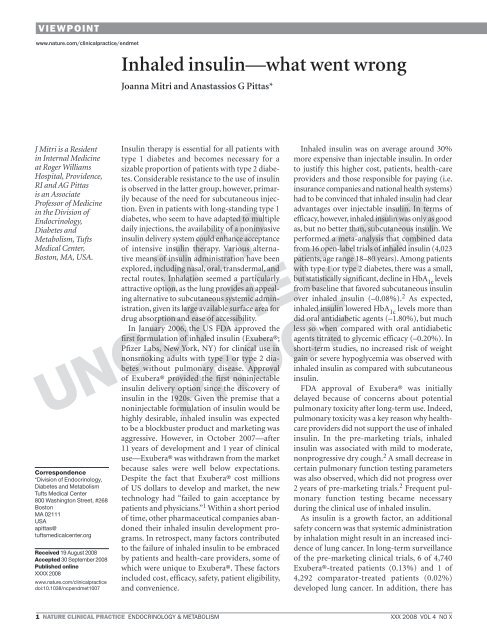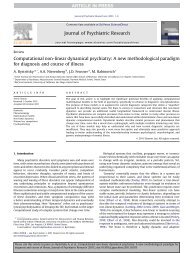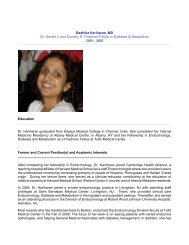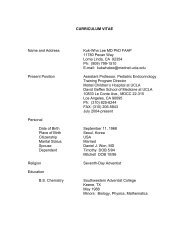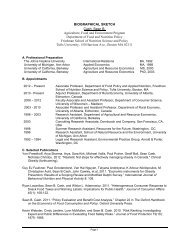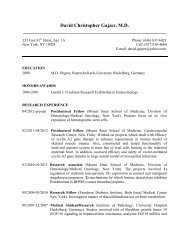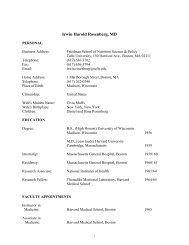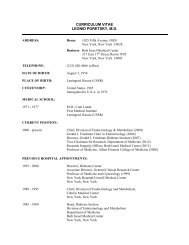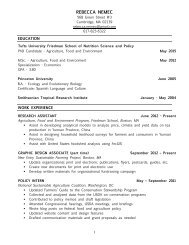NCP UNCORRECTED PROOF - Friedman Diabetes Institute
NCP UNCORRECTED PROOF - Friedman Diabetes Institute
NCP UNCORRECTED PROOF - Friedman Diabetes Institute
Create successful ePaper yourself
Turn your PDF publications into a flip-book with our unique Google optimized e-Paper software.
VieWpoint<br />
www.nature.com/clinicalpractice/endmet<br />
J Mitri is a Resident<br />
in Internal Medicine<br />
at Roger Williams<br />
Hospital, Providence,<br />
RI and AG Pittas<br />
is an Associate<br />
Professor of Medicine<br />
in the Division of<br />
Endocrinology,<br />
<strong>Diabetes</strong> and<br />
Metabolism, Tufts<br />
Medical Center,<br />
Boston, MA, USA.<br />
Correspondence<br />
*Division of Endocrinology,<br />
<strong>Diabetes</strong> and Metabolism<br />
Tufts Medical Center<br />
800 Washington Street, #268<br />
Boston<br />
MA 02111<br />
USA<br />
apittas@<br />
tuftsmedicalcenter.org<br />
Received 19 August 2008<br />
Accepted 30 September 2008<br />
Published online<br />
XXXX 2008<br />
www.nature.com/clinicalpractice<br />
doi:10.1038/ncpendmet1007<br />
Inhaled insulin—what went wrong<br />
Joanna Mitri and Anastassios G Pittas*<br />
Insulin therapy is essential for all patients with<br />
type 1 diabetes and becomes necessary for a<br />
sizable proportion of patients with type 2 diabetes.<br />
Considerable resistance to the use of insulin<br />
is observed in the latter group, however, primarily<br />
because of the need for subcutaneous injection.<br />
Even in patients with long-standing type 1<br />
diabetes, who seem to have adapted to multiple<br />
daily injections, the availability of a noninvasive<br />
insulin delivery system could enhance acceptance<br />
of intensive insulin therapy. Various alternative<br />
means of insulin administration have been<br />
explored, including nasal, oral, transdermal, and<br />
rectal routes. Inhalation seemed a particularly<br />
attractive option, as the lung provides an appealing<br />
alternative to subcutaneous systemic administration,<br />
given its large available surface area for<br />
drug absorption and ease of accessibility.<br />
In January 2006, the US FDA approved the<br />
first formulation of inhaled insulin (Exubera®;<br />
Pfizer Labs, New York, NY) for clinical use in<br />
nonsmoking adults with type 1 or type 2 diabetes<br />
without pulmonary disease. Approval<br />
of Exubera® provided the first noninjectable<br />
insulin delivery option since the discovery of<br />
insulin in the 1920s. Given the premise that a<br />
noninjectable formulation of insulin would be<br />
highly desirable, inhaled insulin was expected<br />
to be a blockbuster product and marketing was<br />
aggressive. However, in October 2007—after<br />
11 years of development and 1 year of clinical<br />
use—Exubera® was withdrawn from the market<br />
because sales were well below expectations.<br />
Despite the fact that Exubera® cost millions<br />
of US dollars to develop and market, the new<br />
technology had “failed to gain acceptance by<br />
patients and physicians.” 1 Within a short period<br />
of time, other pharmaceutical companies abandoned<br />
their inhaled insulin development programs.<br />
In retrospect, many factors contributed<br />
to the failure of inhaled insulin to be embraced<br />
by patients and health-care providers, some of<br />
which were unique to Exubera®. These factors<br />
included cost, efficacy, safety, patient eligibility,<br />
and convenience.<br />
Inhaled insulin was on average around 30%<br />
more expensive than injectable insulin. In order<br />
to justify this higher cost, patients, health-care<br />
providers and those responsible for paying (i.e.<br />
insurance companies and national health systems)<br />
had to be convinced that inhaled insulin had clear<br />
advantages over injectable insulin. In terms of<br />
efficacy, however, inhaled insulin was only as good<br />
as, but no better than, subcutaneous insulin. We<br />
performed a meta-analysis that combined data<br />
from 16 open-label trials of inhaled insulin (4,023<br />
patients, age range 18–80 years). Among patients<br />
with type 1 or type 2 diabetes, there was a small,<br />
but statistically significant, decline in HbA1c levels<br />
from baseline that favored subcutaneous insulin<br />
over inhaled insulin (–0.08%). 2 As expected,<br />
inhaled insulin lowered HbA1c levels more than<br />
did oral antidiabetic agents (–1.80%), but much<br />
less so when compared with oral antidiabetic<br />
agents titrated to glycemic efficacy (–0.20%). In<br />
short-term studies, no increased risk of weight<br />
gain or severe hypoglycemia was observed with<br />
inhaled insulin as compared with subcutaneous<br />
insulin.<br />
FDA approval of Exubera® was initially<br />
delayed because of concerns about potential<br />
pulmonary toxicity after long-term use. Indeed,<br />
pulmonary toxicity was a key reason why healthcare<br />
providers did not support the use of inhaled<br />
insulin. In the pre-marketing trials, inhaled<br />
insulin was associated with mild to moderate,<br />
nonprogressive dry cough. 2 A small decrease in<br />
certain pulmonary function testing parameters<br />
was also observed, which did not progress over<br />
2 years of pre-marketing trials. 2 Frequent pulmonary<br />
function testing became necessary<br />
during the clinical use of inhaled insulin.<br />
As insulin is a growth factor, an additional<br />
safety concern was that systemic administration<br />
by inhalation might result in an increased incidence<br />
of lung cancer. In long-term surveillance<br />
of the pre-marketing clinical trials, 6 of 4,740<br />
Exubera®-treated patients (0.13%) and 1 of<br />
4,292 comparator-treated patients (0.02%)<br />
developed lung cancer. In addition, there has<br />
<strong>NCP</strong><br />
<strong>UNCORRECTED</strong><br />
<strong>PROOF</strong><br />
nature clinical practice ENDOCRINOLOGY & METABOLISM xxx 2008 vOL 4 NO x
een one post-marketing report of primary lung<br />
cancer in a patient treated with Exubera®. 3 All<br />
the patients diagnosed with lung cancer had a<br />
previous history of cigarette smoking, and there<br />
are too few cases to determine whether these<br />
cancers were linked to Exubera®. Nevertheless,<br />
this finding was a significant blow to the concept<br />
of inhaled insulin. Evidence of a decline in<br />
pulmonary function and concerns about the<br />
development of lung cancer, coupled with the<br />
burden of frequent monitoring of pulmonary<br />
function, dissuaded many health-care providers<br />
from prescribing inhaled insulin.<br />
In light of these safety concerns, inhaled<br />
insulin was approved for use only in nonsmoking<br />
patients without chronic lung disease<br />
who had a forced expiratory volume ≥70% of<br />
that predicted for age, sex and height. On the<br />
basis of these requirements, however, it has been<br />
estimated that inhaled insulin would be considered<br />
inappropriate in approximately 40% of all<br />
patients with diabetes mellitus. Furthermore, the<br />
proportion of ineligible patients would increase<br />
to two-thirds after 7 years of use. 4<br />
A key premise behind the development and<br />
marketing of inhaled insulin was the ease of<br />
administration compared with subcutaneous<br />
insulin; however, the first inhaled insulin was<br />
anything but convenient. First, the steps required<br />
for the preparation and delivery of this insulin<br />
formulation were so many and so complicated<br />
that a mnemonic had to be devised by the manufacturer.<br />
Second, the inhalation device had high<br />
maintenance requirements (weekly cleaning,<br />
bimonthly replacements of internal valve, etc.).<br />
Third, the dosing was in mg rather than IU. The<br />
conversion between mg and IU was so compli-<br />
cated that patients were advised to carry and<br />
use a laminated conversion card. Dosing was<br />
also inflexible as the inhaled powder came in<br />
blisters of 1 mg or 3 mg (corresponding to 3 IU<br />
and 8 IU, respectively), which made administration<br />
of small or large doses very challenging.<br />
Fourth, the inhalation device was very bulky,<br />
which made it difficult to convince patients to<br />
exchange small, pen-like injection devices for<br />
inhaled insulin. Finally, inhaled insulin had to be<br />
coadministered with subcutaneous long-acting<br />
insulin, which would require patients to learn,<br />
and health-care providers to teach, two different<br />
methods of insulin delivery.<br />
The lack of convenience afforded by inhaled<br />
insulin might at first seem surprising, as inhaled<br />
insulin rated highly in patient preference surveys<br />
both as a theoretical treatment option and<br />
among patients who were randomly allocated<br />
to inhaled insulin in the pre-marketing trials. 2,5<br />
At least two possible explanations can account<br />
for this discrepancy. First, the trials recruited<br />
patients who were interested in the use of<br />
inhaled insulin. As a consequence, those patients<br />
who received inhaled insulin were naturally<br />
more satisfied than those who did not. Second,<br />
inhaled insulin was compared with syringes and<br />
vials of regular insulin. The landscape of injectable<br />
insulin has changed dramatically over the<br />
past decade. Most patients now use either highaccuracy<br />
insulin pumps or pen-like devices with<br />
needles that are thinner, shorter, sharper, and<br />
much less painful than those previously used.<br />
The introduction of a new class of medications<br />
or technology is generally a welcome addition<br />
to our existing armamentarium against diabetes<br />
mellitus. In general, new products are prized<br />
and are often quickly embraced over older,<br />
well-established and effective products, despite<br />
our limited ability to judge the merits of new<br />
products in relation to long-term effectiveness<br />
and safety in clinical use. 6 Aggressive marketing<br />
campaigns to physicians and direct-to-consumer<br />
advertisement also contribute to early widespread<br />
use of new products. Nevertheless, when<br />
alternatives exist that are safe, tested and effective,<br />
the merits of introducing a new product<br />
need to be weighed carefully against the standard<br />
of care. Inhaled insulin was a rare occasion<br />
in clinical practice when the response of patients<br />
and health-care providers to a new technology<br />
was in line with the unfavorable aspects of the<br />
product, and in opposition to the perceived need<br />
and aggressive marketing by the manufacturer.<br />
Perhaps we, the consumers, have learned our<br />
lesson after all. 6<br />
References<br />
1 Berenson A (2007) Weak sales prompt Pfizer to cancel<br />
diabetes drug [http://www.nytimes.com/2007/10/19/<br />
business/19pfizer.html?ref=business] (accessed 1<br />
October 2008)<br />
2 Ceglia L et al. (2006) Meta-analysis: efficacy and<br />
safety of inhaled insulin therapy in adults with diabetes<br />
mellitus. Ann Intern Med 145: 665–675<br />
3 Exubera® labeling update [http://www.fda.gov/<br />
medwatch/safety/2008/Exubera_DHCP.pdf]<br />
4 Davis TM and Davis WA (2007) An assessment of<br />
eligibility for inhaled insulin (Exubera): the Fremantle<br />
<strong>Diabetes</strong> Study. <strong>Diabetes</strong> Care 30: 360–361<br />
5 Freemantle N et al. (2005) Availability of inhaled insulin<br />
promotes greater perceived acceptance of insulin<br />
therapy in patients with type 2 diabetes. <strong>Diabetes</strong> Care<br />
28: 427–428<br />
6 Eisenberg JM (1999) Ten lessons for evidence-based<br />
technology assessment. JAMA 282: 1865–1869<br />
VieWpoint<br />
www.nature.com/clinicalpractice/endmet<br />
Acknowledgments<br />
The authors’ work is<br />
supported by NIH research<br />
grants R01 DK76092 and<br />
R21 DK78867 (awarded to<br />
AG Pittas).<br />
Competing interests<br />
The authors declared no<br />
competing interests.<br />
<strong>NCP</strong><br />
<strong>UNCORRECTED</strong><br />
<strong>PROOF</strong><br />
xxx 2008 vOL 4 NO x nature clinical practice ENDOCRINOLOGY & METABOLISM


